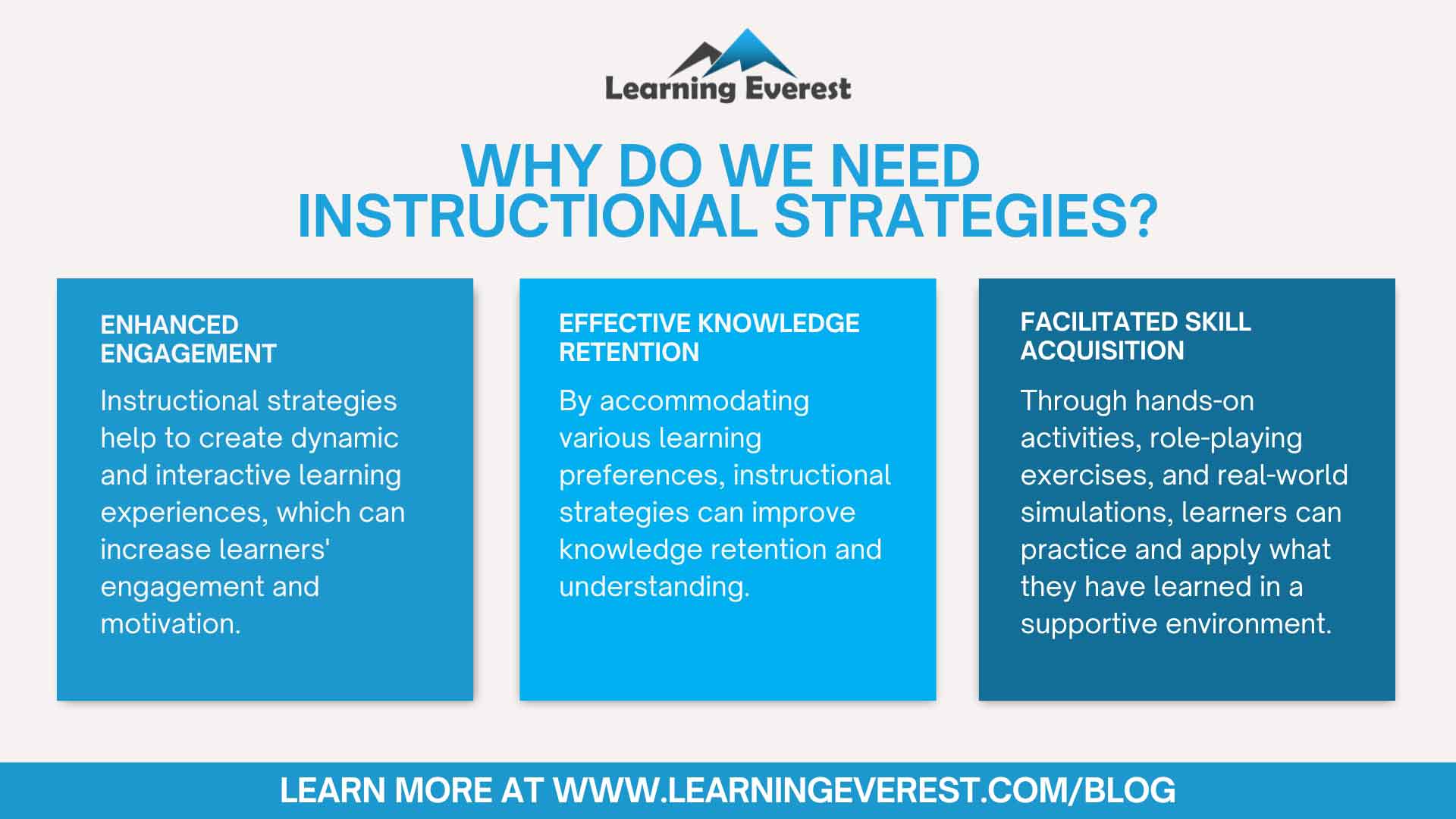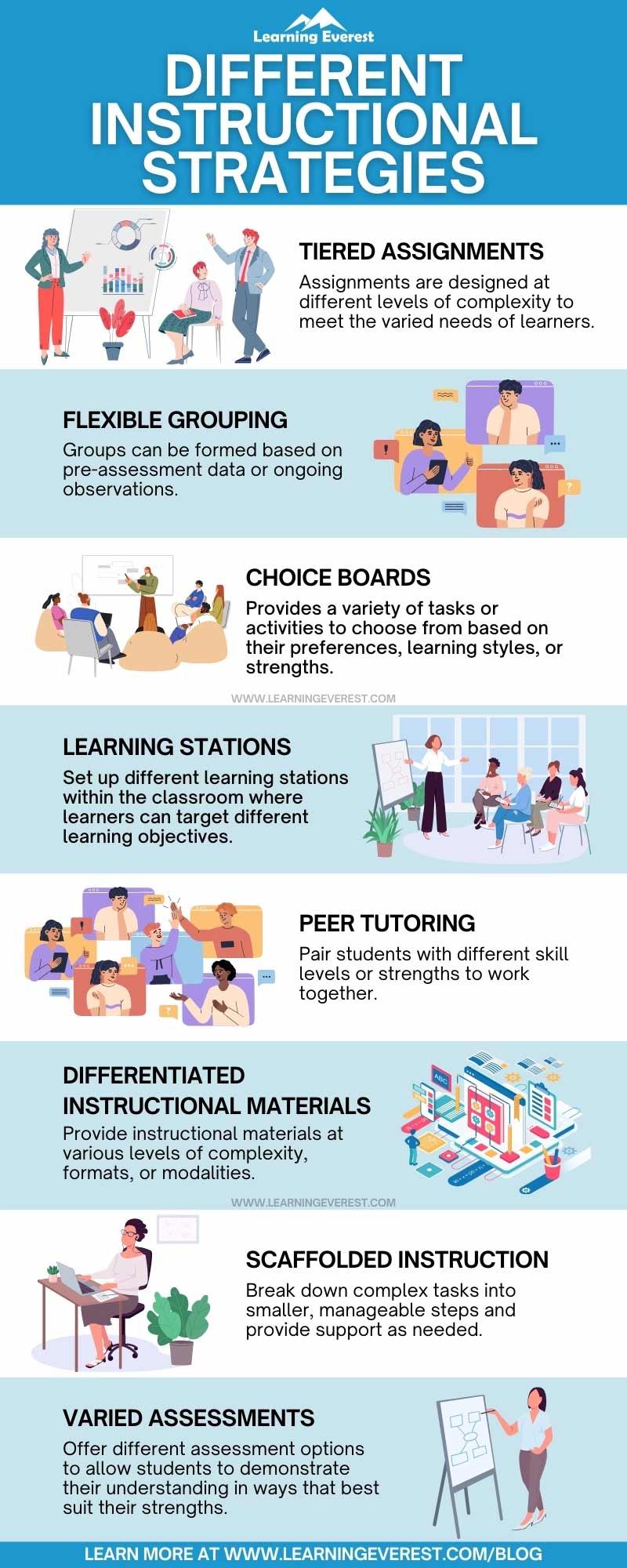Instructional strategies refer to the techniques instructors use to deliver their lessons. Effective instructional strategies help learners become actively involved in the learning process and, when done right, help them reach their learning objectives.
Table of Contents
In this blog, you’ll gain a profound understanding of the various instructional strategies, why they’re important, and how they can benefit both instructors and learners by being applied to the learning process.
What are instructional strategies?
Instructional strategies are techniques or methods used to facilitate effective learning experiences. These strategies are designed to engage learners, enhance understanding, and improve retention of information. The objective of using instructional strategies is to create learners who are independent, strategic learners. The hope is that, with time and practice, learners will be able to select the right strategies on their own and use them to complete tasks.

Why do we need Instructional Strategies?
What’s the difference between instructional strategies, teaching strategies, teaching techniques, and teaching practices?
In the dynamic landscape of adult learning, understanding the nuances between instructional strategies, teaching strategies, teaching techniques, and teaching practices is crucial for educators aiming to enhance their approach.
| Instructional strategies | Teaching strategies | Teaching techniques | Teaching practices |
|---|---|---|---|
| The broad framework for facilitating learning | Specific approaches for conveying information and engaging learners | Hands-on practices for delivering content and fostering understanding | Comprehensive application of instructional, teaching, and technical strategies |
| Guides selection of teaching methods and techniques | Includes collaborative learning, active participation, technology integration | Includes case studies, role-playing, interactive discussions | Tailored to meet learners’ needs and subject matter requirements |
Effective instructional strategies to incorporate
There are far too many kinds of instructional strategies to catalog in one place. And there’s no single, specific way to group them. While the categories below are not exhaustive, instructional strategies often fall under general groupings. As instructors, tailoring our approach to meet the unique needs of adult learners within this context is paramount. Here are several instructional strategies designed to elevate the learning experience, ensuring it is engaging, relevant, and transformative.
1. Utilize the Principles of Andragogy
Understanding the principles of andragogy, or adult learning theory, is foundational. The six main assumptions in Knowle’s andragogy learning theory. They are:
- Self-concept: Adult learners are characterized by their autonomy, independence, and self-direction.
- Learning from Experience: Adults draw upon their past experiences as a valuable source of learning.
- Readiness to Learn: Adult learners are inclined to engage with relevant and meaningful subjects, reflecting their readiness to learn.
- Immediate Applications: Adult learning emphasizes practical, immediate applications over theoretical or future-oriented knowledge.
- Internal Motivation: Adults are primarily driven by personal, internal factors rather than external influences.
- Need to Know: Adult learners seek an understanding of the value and purpose behind their learning endeavors.
These Malcolm Knowles 6 principles of learning guide practitioners of andragogy in delivering learner-centered education. Instructors should leverage these as invaluable resources by:
- Recognizing the diverse experiences learners contribute.
- Facilitating rather than dictating learning.
- Encouraging collaborative learning experiences.
- Integrating real-world problems that learners can solve by applying new knowledge.
2. Embrace a Learner-Centered Approach
A learner-centered approach in L&D and corporate training focuses on the learner’s needs, abilities, and learning styles. This approach shifts the emphasis from the traditional instructor-led methods to a more individualized and active learning process.
Effective learning happens simply as a result of the learning that a learner is needed. The learner finds, accesses, consumes, understands, and then eagerly applies it to the workplace. Crafting effective learning solutions necessitates adhering to a learner-centered approach. So, what does that mean? It requires that L&D teams put the learner at the center when producing learning content:
- First, understand who your learners are and what their learning needs are.
- Then, customize your learning content to meet those expectations.
- Finally, tailor your delivery, including choosing the most appropriate training technology to fit their individual learning styles/preferences.
Embrace this learner-centered training philosophy and consistently generate effective learning experiences that align with your goals! Learners will not only actively seek your training solutions but will also enjoy the learning journey you deliver.
3. Foster a Collaborative Learning Environment
Collaborative learning is an approach that involves learners working together in small teams to achieve a common objective, such as solving a problem, completing a project, or creating a product. Collaborative learning can foster more profound understanding, critical thinking, creativity, and communication skills among learners. It can also increase their motivation, engagement, and satisfaction with their learning experience. To implement collaborative learning effectively, you must design meaningful and challenging tasks, provide clear instructions and expectations, facilitate group interactions, and monitor and assess the learning process and outcomes. Collaboration enhances learning by leveraging the collective knowledge and experience of the group. Techniques to foster a collaborative environment include:
- Group projects and discussions.
- Peer review and feedback sessions.
- Collaborative problem-solving activities.
- Use of collaborative tools and platforms to facilitate interaction.
4. Implement Blended Learning Solutions
Blended learning is a tool that combines traditional classroom training and eLearning. It offers a plethora of instructional structures to help learners. A mix of face-to-face, classroom-based, and online training and development programs is an effective strategy to address various learning phases and maximize learning.
Blended learning = Traditional Instructor-Led Training + Online Learning (synchronous and asynchronous) + Performance Support
Blended learning designs a variety of training formats based on your learner’s need, their profile, and the overall learning environment. This combination of in-person and virtual training models offers learners an engaging and immersive learning experience. Effective blended learning involves:
- High-quality digital resources that complement in-person sessions.
- Opportunities for self-paced learning alongside scheduled group sessions.
- Use forums, chats, and video conferencing to maintain engagement and facilitate discussion.
Though most organizations consider training and development an annual event, learning is more of a process. It is a journey that involves moving from ignorance to awareness to excellence of the subject.
5. Incorporate Microlearning
Microlearning involves delivering content in small, specific bursts that are easier to assimilate and retain. It can improve on-the-job training because employees will learn in a short period of time without disrupting their daily tasks. This is possible because microlearning prioritizes information that may be more relevant to a daily job.
This strategy can:
- Provide just-in-time learning that directly applies to the learner’s current tasks or projects.
- Increase engagement through short, focused sessions.
- Facilitate better retention and application of new knowledge and skills.
6. Leverage Technology Wisely
To optimize your corporate learning management, what better way to proceed than harnessing the power of modern technology? Digital tools and technological resources used for training can streamline processes, facilitate better learning, and aid mentors and trainees. The benefits of corporate learning and development programs are multifold. Consider:
- Use learning management systems (LMS) to track progress and provide personalized learning experiences. Establishing an e-learning platform is the first step in investing in LMS. With the help of technology, here are learning resources you can develop for your training.
- Incorporating interactive elements such as simulations, games, and quizzes to enhance engagement. Consider leveraging virtual reality (VR) and augmented reality (AR) for an enhanced experience.
- Utilizing analytics to understand learner engagement and the effectiveness of the material.
7. Encourage Reflective Practice
Reflective practice is the foundation of modern-day professional development; it makes meaning from real-life experience and transforms insights into practical strategies for growth and organizational impact. Integrating activities into daily life routines raises awareness, prompts critical analysis, and aids self-management and decision-making. Instructors can encourage reflective practice by:
- Prompting learners to journal or discuss their learning experiences.
- Incorporating regular feedback sessions where learners can reflect on their progress.
- Using case studies and scenarios that prompt critical thinking and reflection.
Thinking about an experience is essentially a cognitive activity, but reflection is emotional and physical and linked with our values and social identity. Viewing issues from various perspectives challenges assumptions and established patterns of behavior and encourages the development of new ways of seeing. Transformational theories suggest that adult learning is principally a meaning-making activity and that acquiring job-specific skills and spending time on continuous professional development creates the opportunity to gain a profound understanding of self as a learner and acquire a body of knowledge.
To sum up
Corporate training is crucial in business. It primarily aims to enhance the employees’ knowledge and skills. Along with this is to address performance gaps, increase workforce potential, ensure employee satisfaction, increase business productivity, and more. Instructors play a critical role in facilitating meaningful learning experiences. By adopting these instructional strategies, instructors can ensure that their approach is educational and transformative, equipping adult learners with the skills and knowledge they need to succeed in today’s competitive business world.
Infographic

Different Instructional Strategies
Knowledge Check!
Frequently Asked Questions (FAQs)
Q: What are instructional strategies?
A: Instructional strategies are techniques or methods used to facilitate effective learning experiences. These strategies are designed to engage learners, enhance understanding, and improve retention of information.
Q: How many types of instructional strategies are there?
A: There are far too many kinds of instructional strategies to catalog in one place. And there’s no single, specific way to group them.
Q: Why are instructional strategies important?
A: Instructional strategies encompass any type of learning technique an instructor uses to help learners gain a better understanding of the training material. They allow instructors to make the learning experience more fun and engaging and can also encourage learners to take more of an active role in their education.





